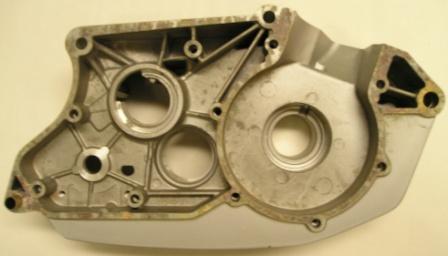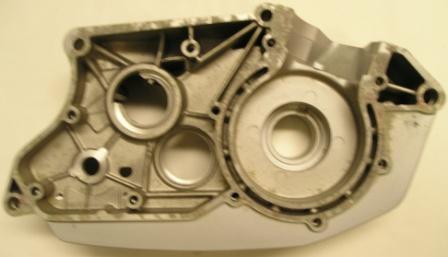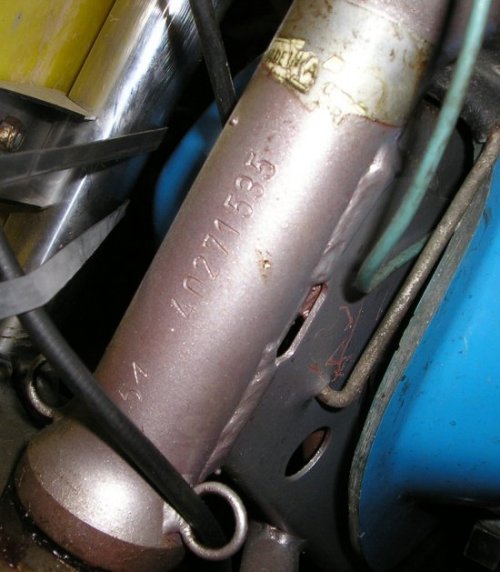Year, Size, Model Identification (Penton bikes)
Every work day I receive calls from someone looking for parts to restore or repair one of the many models of Penton and KTM motorcycles that were sold from 1968 thru 1982. I am pretty good at knowing what some of the parts many people are calling about, especially if I know what year, model, and size of motor the bike is. It saves a lot of time if the caller knows this information before calling. It also helps if the caller has a part number to identify exactly what part that they are looking for.
To identify what year, size, and model Penton or KTM bike you have, write down the serial number off of the frame (stamped on the steering head).
On the Sachs motors there is a metal plate riveted on the top of the ignition case. Write down the numbers engraved on the plate (e.g.. 1251/6B). This information identifies what style of motor it is however, it may not be accurate because many original cases were thrown out and replaced with another used one when they were busted up from a thrown chain.
Sachs motors were made with 5 and 6 speed transmissions. There were also different versions of transmissions and cases made. These are identified as A, B, or D. The parts for all of these versions of motors are not all the same and even though some look the same and will fit, they will not work. The Sachs motors are fine engineered machines designed to allow the internal moving parts to be precisely assembled. This is why everything is shimmed out. The parts lists show illustrations of every part on the bike frame and in the motors as well as all of the different versions of motor parts. This is useful as a guide to help identify exactly what type of motor that you have.


photo of "A" engine case half photo of "B" engine case half
A visual identification can be made to determine if it is an "A" or "B" engine by looking at the 2 photos above. The "A" engine has a larger diameter crank than the "B". Thus, the "A" engine case has a larger crank area which is identified with having only a "single" wall around the outside of the crank area as shown in the "A" photo. The "B" engine has a smaller crank area which has a "double" wall around the outside of the crank area as shown is the "B" photo.
photo of "A" mainshaft and bearing "B" mainshaft and bearing
SACHS MAINSHAFTS - warning
There are 2 styles of mainshafts used in the Sachs engines, an "A" mainshaft and a "B" mainshaft.
The "A" mainshaft uses a selector rod that measures 8mm on the end with a 8mm key that screws onto it.
The "B" mainshaft uses a selector rod that measures 10mm on the end with a 10mm key that screws onto it.
The "A" mainshaft uses a 20 x 42mm ball bearing on the end and cannot be used in a "B" bottom case.
The "B" mainshaft uses a 25 x 47mm ball bearing on the end and cannot be used in a "A" bottom case.
SACHS CLUTCH BASKETS
There are 2 sizes of clutch baskets used in the Sachs A and B engines.
The early Sachs "A" engines came with clutch baskets that are 39.5mm high. These use clutch springs(#0239-015-000) that are 21mm long.
The Sachs "B" engines came with clutch baskets that are 41.5mm high.
These use clutch springs (#0636-106-000) that are 22.3mm long
photo of 39.5mm basket and spring - 41.5mm basket and spring
These most common problem with Sachs clutches is stuck plates from sitting unused for long periods of time. The friction plates attract moisture and this causes the steel plates to rust to the fiber plates. The fix is to pry the plates apart and to clean both the steel and fiber plates with steel wool to remove the rust. The fiber plates will last a long time and do not need to be replaced unless there are chunks of material missing (from prying apart). The steel plates only need to be replaced if the fingers of the plates are mushed up from banging into the sides of the basket. The basket needs to be replaced if the edges are severely saw toothed from the steel plates.
If you are experiencing clutch slippage, check the clutch basket to see if there is severe saw toothing. This can cause the plates to hang up and not seat properly. Also check for broken or missing clutch springs and making sure the correct length of springs are installed.
The brass or steel bushing in the center of the clutch flywheel should be checked tightness. If there is noticable wobble of the clutch assembly on the layshaft, then the bushing should be replaced.
Penton Frame Identification
 The Penton/ KTM frame serial
numbers contain a date code that identifies what month and year the bike
was built. These number are stamped on or around by the steering head. In most cases (from 1972+) the first three numbers are the
date code. The first number is the year, the next two are the month (e.g..
403 = March of 1974).
The Penton/ KTM frame serial
numbers contain a date code that identifies what month and year the bike
was built. These number are stamped on or around by the steering head. In most cases (from 1972+) the first three numbers are the
date code. The first number is the year, the next two are the month (e.g..
403 = March of 1974).
NOTE: All 1968 thru 1971 "steel tank" bikes have a "V" serial number stamped on the steering head. The actual year for these bikes is determined by the number sequence and can be complicated to figure out. See the "Penton Owners Group web site for more information about this. www.pentonusa.org.
Owners Manuals (for all Sachs 100 & 125 engines)
Owners manuals are a must for anyone who has a Penton motorcycle. It not only gives you step by step instructions on how to tear down the motor and rebuild it, it also gives all of the specifications for the bike along with recommended maintenance and adjustment of all of the components on the bike. For anyone who has just obtained a Penton for the first time, the owners manual is a must. The manual should be read first before tearing into anything on the bike!
Owners manuals are available. They come in an indexed ring binder. There are two versions - one for the bikes with Sachs motors - the other for bikes with KTM motors. The Sachs version can also be used for working on DKW, Sachs, Dalesman, Rupp's, Monarks, and any other bike brand that are powered with the Sachs 100 and 125 motors.
Parts Lists
Parts lists are available showing every part on the bike and motors and identify everything with a part number. The illustrations help in determining if something is missing, what order the parts go in assembly, and how many there should be. The part numbers help you to obtain the exact part that you need when ordering.
For the 1968 thru 1973 Penton motorcycles they are sold by model size. Parts lists are also available for 1968 and 1972 DKW and Sachs motorcycles. See the "Penton/ Sachs/ DKW Parts List" page for pricing.
PISTON SPECIFICATIONS
When to Rebore a Cylinder
Maximum allowable piston to cylinder clearance
100cc - .005” + piston clearance
125cc - .0055” to .006”
Specifications for Ring End Gaps
minimum - maximum
100cc - .004 - .005 (.010)
125cc - .007 - .008 (.015)
Clearance Specs for Boring Cylinders
100cc - .0015” to .002”
125cc - .0025” to .003” Wiseco "M" series pistons - 0.0019 (0.048mm)